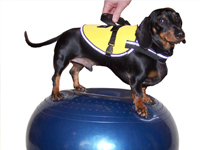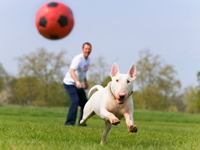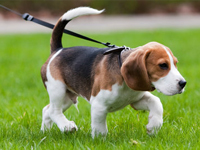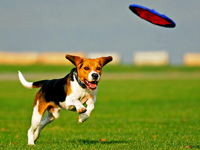 We often take for granted that an animal is balanced, and don’t consider the necessity of attempting to improve upon it. Balance is the ability to adjust equilibrium at a stand, or during locomotion to adjust to a change in direction or to changes in the ground surface. For us humans, pilates exercises seek to improve balance. (I never questioned my own balance until I took a series of pilates classes, as the weeks progressed, I definitely improved.)
We often take for granted that an animal is balanced, and don’t consider the necessity of attempting to improve upon it. Balance is the ability to adjust equilibrium at a stand, or during locomotion to adjust to a change in direction or to changes in the ground surface. For us humans, pilates exercises seek to improve balance. (I never questioned my own balance until I took a series of pilates classes, as the weeks progressed, I definitely improved.)
 Dogs that have recently recovered or who are in the process of recovering from an orthopedic or neurologic injury or disease benefit from balance-improving exercises. Improving balance can also benefit dogs with arthritis. The exercises are easy to teach which makes them good additions to your dog training program. Anything we can do that includes teaching our dogs skills and spending active time with them, will improve dog behavior. And who doesn’t want that?
Dogs that have recently recovered or who are in the process of recovering from an orthopedic or neurologic injury or disease benefit from balance-improving exercises. Improving balance can also benefit dogs with arthritis. The exercises are easy to teach which makes them good additions to your dog training program. Anything we can do that includes teaching our dogs skills and spending active time with them, will improve dog behavior. And who doesn’t want that?
 The simplest balance exercises involve responses to changes in surfaces: walking on a trampoline, standing on a wobble board or a see-saw, standing on the hind limbs while moving forward as you hold the front limbs, walking on foam or pillows. We set up cavaletti rails at various height and distance from each other and have the dog walk and trot through.
The simplest balance exercises involve responses to changes in surfaces: walking on a trampoline, standing on a wobble board or a see-saw, standing on the hind limbs while moving forward as you hold the front limbs, walking on foam or pillows. We set up cavaletti rails at various height and distance from each other and have the dog walk and trot through.
More difficult/advanced exercises involve exercise balls where the dog first stands and then learns to change positions (sit, stand, down) while maintaining balance on the exercise ball. This is more difficult than it sounds, requiring a strong core. For all movements on the ball, the dog will keep his core abdominal muscles tight. Imagine how you would do standing and then sitting on a large inflated ball. It is definitely a good work out!
 Improving your dog’s balance is especially important if the dog competes in sports requiring quick movements (IPO, agility, herding, Frisbee…). Learning how to do these exercises correctly and safely can improve your dog’s performance and lessen his chances of injury.
Improving your dog’s balance is especially important if the dog competes in sports requiring quick movements (IPO, agility, herding, Frisbee…). Learning how to do these exercises correctly and safely can improve your dog’s performance and lessen his chances of injury.

Recent Comments